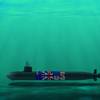RIMPAC Exercise Puts LCS Through Paces
It was the middle of May, and the littoral combat ship Independence was operating out of San Diego, testing components of the mine warfare mission package. The mission is one that, except for several extended overhaul periods, has consumed much of the ship’s operating time since the class-leading vessel was commissioned in January 2010.
Word then came down from the highest levels of US Navy leadership — Independence was going to Pearl Harbor to take part in the world’s largest naval exercise, Rim of the Pacific (RIMPAC). The event, held every two years, was only weeks away from beginning. To get there on time, the LCS would have to rapidly switch gears — offloading the mine equipment, loading a surface warfare mission package, checking out scores of systems — many of which had not been used operationally by an Independence-class ship.
“The No. 1 thing to do was swap mission packages,” Capt. Randy Garner, commodore of LCS Squadron 1 and a former LCS commander, said in an Aug. 14 interview. “We put the surface warfare package on board, with 19 sailors, two 30mm guns, a couple 11-meter rigid-hull inflatable boats [RHIBs], and an aviation detachment with two MH-60S helicopters.”
LCS was designed to be able to swap out mission packages, but this was much closer to a real world situation than a test for the ship.
“We transferred packages in 96 hours,” said Cmdr. Michael Smith, executive officer of Independence until just before the RIMPAC deployment, and now the ship’s commanding officer. “The ability to swap out one mission package to another and exercise that equipment was validated in that time frame.”
A key priority was testing the 30mm guns, which Independence had rarely carried in four years of active service.
“Right after they were installed, we carried out integration testing and got underway to fire the guns,” Smith said. Firings continued even as the ship sailed to Hawaii.
The aviation detachment also had to be qualified.
“We’d been working with them a little bit prior to RIMPAC,” Smith said. “But this was a very high operating tempo, working through all certifications, including VBSS [visit, board, search and seizure] operations.”
Crew members also exercised the big 11-meter RHIBs, launched using a twin-boom extensible crane, a feature of the trimaran ships, which do not use ramps. “It was a very busy time,” Smith said.
The ship’s combat system and communications suite also had to be fully brought on line, Smith added, including Link 16 — a Navy tactical data link — the Global Command and Control System-Maritime, Identification Friend of Foe, and numerous other systems, all being used in exercises for the first time.
Despite being a late add to RIMPAC, Independence took part in a variety of scenarios. One of the first was to act as plane guard for the aircraft carrier Ronald Reagan, a role that called for the ship to integrate communications and combat systems within the strike group.
“We received a Bravo Zulu” — Navy-speak for well done — “from the Reagan strike group commander for having sustained operations with Link 16 in a strike group environment,” Smith said.
Independence also went four-on-one with a group of warships.
“We played [opposition force] against four other vessels, two foreign and two US,” Smith said. “In a four-hour event, we got almost two hours without being seen.” Operating within a proscribed area, the ship, he said, “went all dark, [emissions control] silent, sprint and drifted, used lowest radar cross section against their helos. I think we did pretty well, you could see their helos coming toward us and then going away.”
The LCS also performed its first joint combined operations with special operations forces.
“We acted as an afloat forward staging base,” Smith said. The helo crews from Helicopter Sea Combat Squadron 6 “were very adept at doing fast-rope operations,” operating with Marine special operators, US Navy and South Korean SEALs, Peruvian special forces and a US Coast Guard maritime safety and security team.
VBSS teams from Independence, Smith added, also performed boarding and search exercises aboard the Chinese destroyer Haikou and frigate Yueyang. Chinese teams, he said, did not perform similar exercises on Independence.
The ship, Smith said, showed it could operate two helicopters “nearly simultaneously,” while launching and recovering its boats.
“Our ability to do that with assault teams, race the ship, have the helos, the RHIBs and the ship with its guns pointing at them — it’s pretty awe-inspiring, the target ships have told us,” he said.
Through it all, Independence and its crew performed well, the two reported. Asked about the combat system and the crane, they said there were no significant problems.
“We don’t have a long list of painful lessons learned,” Garner said. “They’re the kind you want — minor adjustments, minor improvements.
“This was a good set of challenging problems. We got an opportunity to test the ship in an environment we’d never had to before,” Garner added.
“We were assigned two to three missions per day,” Smith said. “We made and executed every single mission, didn’t have to pull into port once. We only refueled twice during the RIMPAC events. We were a busy ship.”
Smith acknowledged there had been some doubts about how the LCS would do in RIMPAC.
“I think everyone was waiting for us to pull back in to Pearl Harbor with some casualty. Well, we didn’t. There was no drama,” he said.
“For the crew, it was a validation of all the things they knew about the ship. No spin — we left alone, and we came back part of the fleet.”











